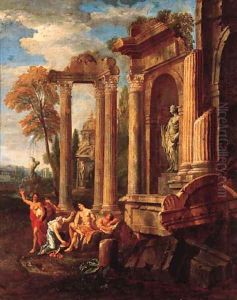Johann Heinrich Schnfeldt Paintings
Johann Heinrich Schönfeld, also spelled Schönfeldt, was a prominent German Baroque painter born in Biberach an der Riß, Swabia, in 1609. Known for his dynamic and expressive works, Schönfeld was a master of both historical and mythological subjects, as well as landscape paintings.
Schönfeld's early life was marked by his training in the artistic environments of Augsburg and Munich. He was heavily influenced by the works of great Flemish and Italian artists of the time, such as Peter Paul Rubens and the Carracci family. After his initial training, Schönfeld traveled to Rome around 1633, where he was profoundly influenced by classical art and the emerging Baroque style. During his time in Italy, he also visited Naples, where he was exposed to the naturalistic styles of Ribera and Caravaggio.
By 1635, Schönfeld had returned to Augsburg, where he became a leading figure in the local art scene. His work was characterized by dramatic use of light and shadow, vigorous brushwork, and a keen sense of movement and emotion, which were hallmarks of the Baroque style. Schönfeld's paintings often depicted scenes from the Bible, ancient history, and mythology, as well as landscapes and genre scenes.
In 1643, Schönfeld moved to the imperial city of Nuremberg, where he became a member of the city's council. His reputation continued to grow, and his studio attracted many students and admirers. Schönfeld's success allowed him to live comfortably, and he acquired a significant personal art collection.
Despite the popularity of his work during his lifetime, Schönfeld's fame waned after his death in 1684. It was not until centuries later that art historians reevaluated his contributions to the Baroque movement and recognized his talent. Today, Schönfeld's works can be found in numerous museums and collections, and he is celebrated for his unique contributions to German Baroque painting.
